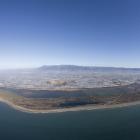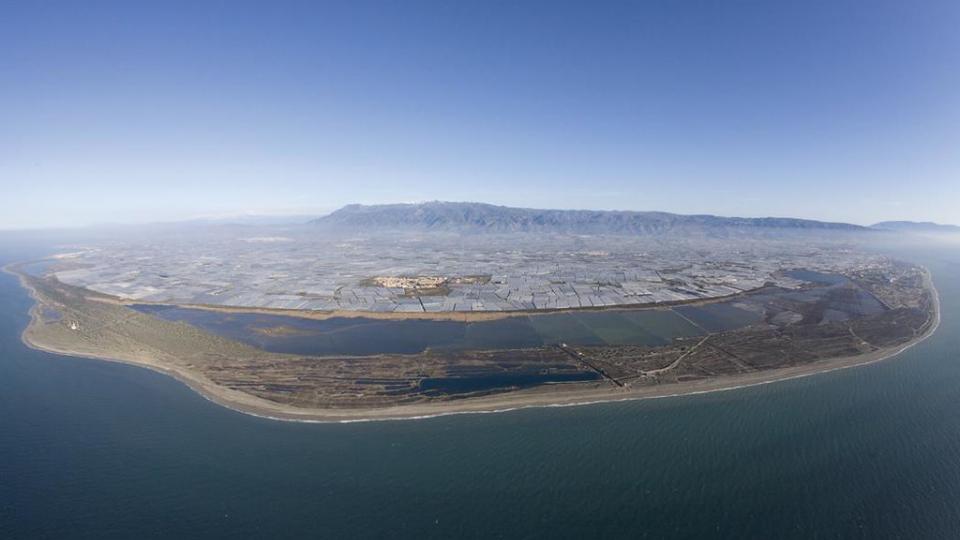
Aerial view of the Campo de Dalías with about 20,000 hectares of plastic greenhouses.
Aerial view of the Campo de Dalías with about 20,000 hectares of plastic greenhouses.
2009 Pere Papasseit
Accessed via Flickr on 28 April 2021. Click here to view source.
 This work is licensed under a Creative Commons Attribution-NoDerivs 2.0 Generic License.
This work is licensed under a Creative Commons Attribution-NoDerivs 2.0 Generic License.
Imagine if one of the driest places in Europe were to produce one of the largest fruit and vegetable crops on the continent. This is exactly what has happened in the southern Spanish region of Almería since the 1950s. A few kilometers southwest of Almería, between the Sierra de Gádor mountain range in the north and the Mediterranean coast in the south, lies the Campo de Dalías plain. This is where the region’s largest concentration of greenhouses is located today, an area of about twenty thousand hectares under plastic sheeting. Despite an annual rainfall of less than 250 mm, it was thanks to the milagro Almeriense (Almerian miracle) that the “vegetable garden of Europe” was created.
The history of this so-called miracle, as it is often referred to in the region, is commonly linked both in the media and in historical research with the history of people who were pioneers of a new type of agriculture. Similarly, the roles of the state and state-initiated projects in the so-called modernization of the region are often addressed and mostly framed in a very positive light. But another factor besides these human actions is obvious and yet insufficiently considered: the materiality of the “miracle.” This is because the alleged miracle is not only based on inventive human actors, but also has an important material dimension, ranging from technical equipment to new materials such as plastics.
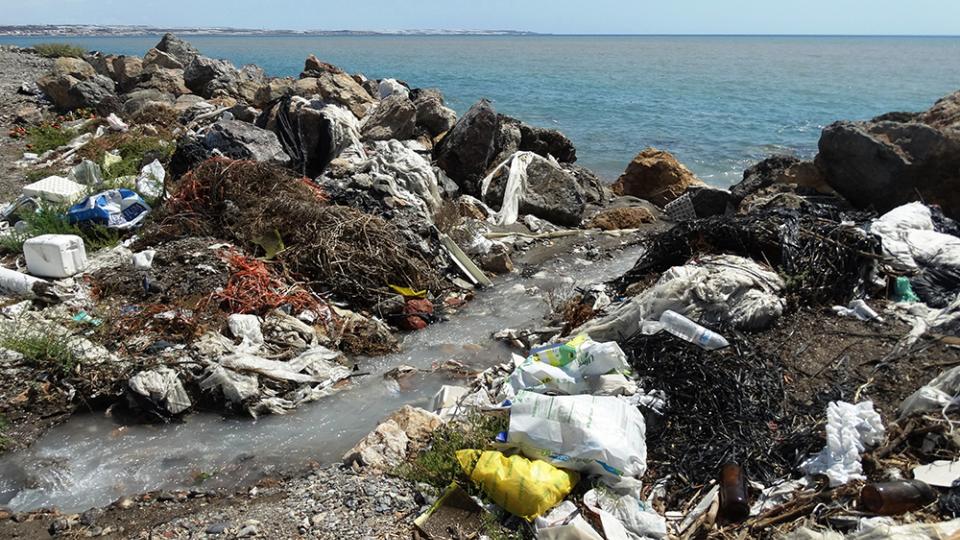
Plastic waste on the coast of the Campo de Dalías. An inadequate waste disposal system allows plastic components such as no longer used tarpaulins, nets and canisters to become part of the landscape.
Plastic waste on the coast of the Campo de Dalías. An inadequate waste disposal system allows plastic components such as no longer used tarpaulins, nets and canisters to become part of the landscape.
Courtesy of Emilio González Miras, SERBAL.
Unknown photographer, c. 2015.
Used by permission
The copyright holder reserves, or holds for their own use, all the rights provided by copyright law, such as distribution, performance, and creation of derivative works.
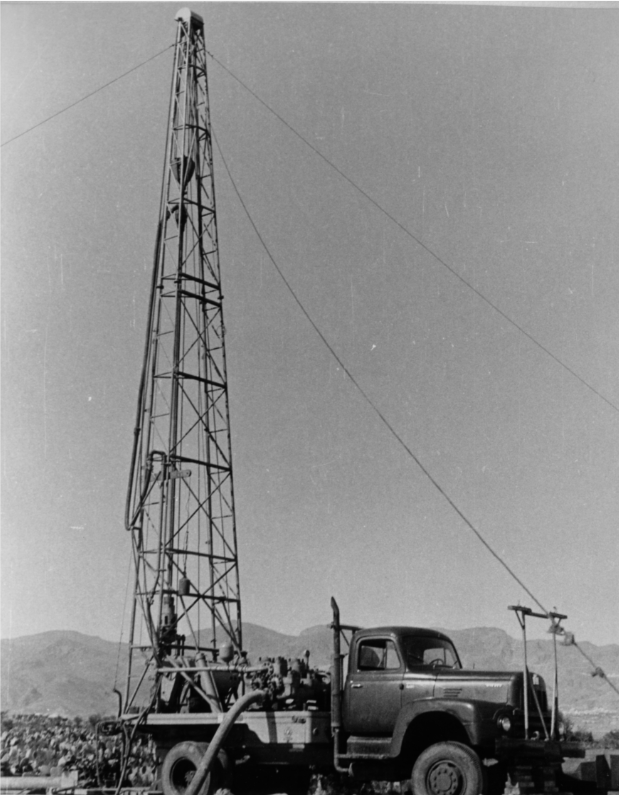
Boreholes, like this one in Nijar, were drilled in many places in the province of Almeria to access groundwater resources.
Boreholes, like this one in Nijar, were drilled in many places in the province of Almeria to access groundwater resources.
Unknown photographer, n.d.
Courtesy of the the Ministerio de Agricultura, Pesca y Alimentación.
Used by permission.
The copyright holder reserves, or holds for their own use, all the rights provided by copyright law, such as distribution, performance, and creation of derivative works.
The origin of the modernization project in the Campo de Dalías dates back to the early years of the Franco dictatorship (1939–1975). Because of the country’s political isolation and in order to counter various economic crises and the problem of rural exodus, the regime founded the Instituto Nacional de Colonización (INC) in 1939. The task of this authority was to boost the country’s agricultural production by settling and irrigating previously remote areas. As a result, in 1941 the Campo de Dalías was declared by decree as an area of “national interest,” and ten years later the “groundwater supply for the irrigation” was declared a task “of public utility and urgency.” In fact, until then, the area was not an empty landscape, but a semi-arid ecosystem sparsely populated by humans, with extensive agriculture and an underground water supply inaccessible to humans. This changed only with the increasing presence of drilling rigs and pumping equipment, which were brought to the region by the INC, together with other earth-moving machinery, financed by US capital after 1953 (Pact of Madrid). By using a wide variety of materials, entire settlements were built, infrastructures expanded, and new agricultural techniques established.
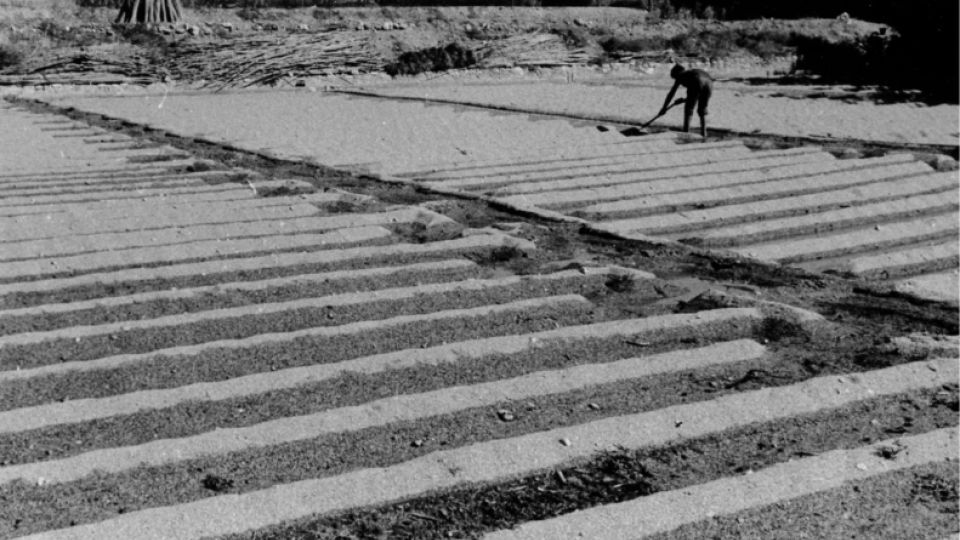
Example of the “enarenado” cultivation in the area of Dalias, initially applied outdoors without greenhouses.
Example of the “enarenado” cultivation in the area of Dalias, initially applied outdoors without greenhouses.
Unknown photographer, n.d.
Courtesy of the the Ministerio de Agricultura, Pesca y Alimentación.
Used by permission.
The copyright holder reserves, or holds for their own use, all the rights provided by copyright law, such as distribution, performance, and creation of derivative works.
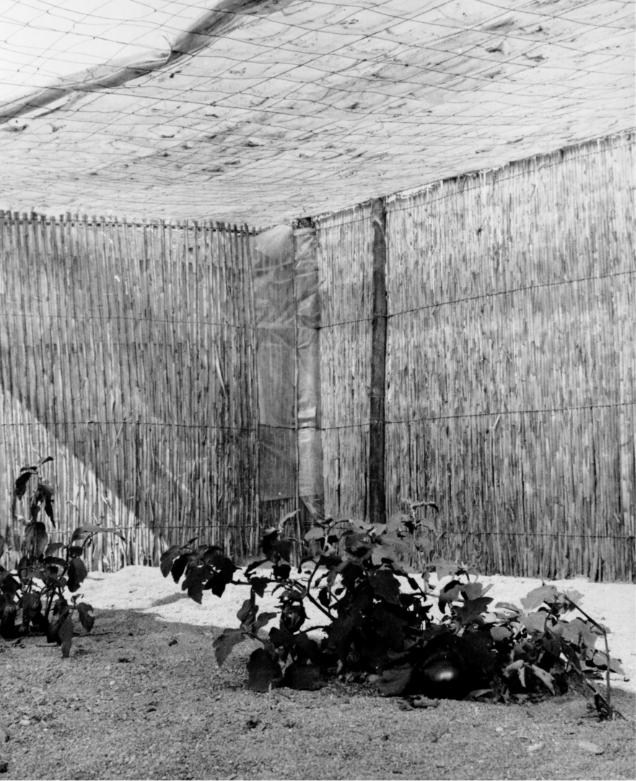
Interior view of one of the first greenhouses in the Dalias area.
Interior view of one of the first greenhouses in the Dalias area.
Unknown photographer, n.d.
Courtesy of the the Ministerio de Agricultura, Pesca y Alimentación.
Used by permission.
The copyright holder reserves, or holds for their own use, all the rights provided by copyright law, such as distribution, performance, and creation of derivative works.
In 1955, enarenado cultivation was practiced for the first time, whereby a layer of manure was first piled over the natural soil and then on top of it a layer of sand. This method stimulated the growth of plants by warming the sand through the sun while simultaneously protecting the soil from drying out. This most visible expression of agrarian modernization around Almería has its origin in the early 1960s. After experiments with different forms of wind protection and coverings for cultivated crops, it turned out that cultures that grew under closed polyethylene covers were the most productive. Inside these first greenhouse constructions, the air warmed up much faster than outdoors due to the sun’s radiation, and at the same time protection from wind helped to keep the humidity higher. This resulted in earlier harvests and longer production times throughout the year. But people had to learn soon that simple polyethylene tarpaulins were not a durable cover due to the natural conditions like sea wind and heat. As a result, the greenhouse became not only a place of agricultural production, but also a field of scientific experiments to improve the materials involved. To ensure the irrigation of the crops, canals were constructed and the Benínar Reservoir was built (1983), for which an entire village had to be dismantled. By the mid-1980s when official authorities had to declare threat to the region’s groundwater resources, the greenhouse area already covered about ten thousand hectares. Both groundwater development and the expansion of irrigated areas were then legally regulated—with limited success, as can be seen in retrospect.

Sand extraction for the “enarenado” cultivation on the beach of Roquetas de Mar.
Sand extraction for the “enarenado” cultivation on the beach of Roquetas de Mar.
Courtesy of Alfonso Ruiz García, Instituto de Estudios Almerienses – Almería (España)
Photograph by Bernabé Aguilar Arigo, n.d.
Used by permission.
The copyright holder reserves, or holds for their own use, all the rights provided by copyright law, such as distribution, performance, and creation of derivative works.
The material changes up to the 1980s deeply shaped the landscape and its natural resources, whereas in the last thirty years the materiality in and of the greenhouse itself has increasingly been subject to transformation. The economic pressure to generate higher yields on the same area as well as an emerging sustainability discourse resulted in various changes. Examples include the introduction of drip irrigation (1977), thermal plastic (1982), soilless substrates (1990), pollination by bumblebees (1991), and integrated production (2003). While the newly introduced materials in the first decades of the “Almerian miracle” primarily had the character of innovative support for agricultural modernization, many substances, above all plastics and pesticides, have been perceived as an ecological problem since the 1990s. Therefore, aside from admiration for what humans have accomplished in the region, one should acknowledge that the “Almerian miracle” is essentially based on the involved materialities and therefore simply follows the natural laws. In other words, the cultivation of irrigation-intensive fruits and vegetables in one of the driest regions of Europe is not an inexplicable miracle, but was made possible by a material world that also had its downsides. Acknowledging this reality and not supporting an unreflective glorification of the past is the right approach to thinking about sustainable paths for Almerian agriculture in the twenty-first century.
How to cite
Jünger, Andreas. “Revealing the ‘Almerian Miracle’: Materiality of the Agrarian Modernization in the Campo de Dalías.” Environment & Society Portal, Arcadia (Spring 2021), no. 17. Rachel Carson Center for Environment and Society. doi:10.5282/rcc/9300.
ISSN 2199-3408
Environment & Society Portal, Arcadia
 This work is licensed under a Creative Commons Attribution 4.0 International License.
This work is licensed under a Creative Commons Attribution 4.0 International License.
2021 Andreas Jünger
This refers only to the text and does not include any image rights.
Please click on an image to view its individual rights status.
- Aznar-Sánchez, José Ángel, and Andrés Sánchez-Picón. “Innovación y distrito en torno a un ‘milagro’: La configuración del sistema productivo local de la agricultura intensiva de Almería.” Revista de Historia Industrial 42 (2010): 157–193.
- Castro, Antonio J., et al. “Six Collective Challenges for Sustainability of Almería Greenhouse Horticulture.” International Journal of Environmental Research and Public Health 16 (2019): 4097.
- García Latorre, Juan, Andrés Sánchez Picón, and Jesús García Latorre. “The Man-Made Desert: Effects of Economic and Demographic Growth on the Ecosystems of Arid Southeastern Spain.” Environmental History 6 (2001): 75–94.
- Jiménez Díaz, José Francisco. “Procesos de desarrollo en el Poniente Almeriense: Agricultores e inmigrados.” Revista de Estudios Regionales 90 (2011): 179–205.
- Martínez Rodríguez, F. Javier. “Cambio tecnológico en el aprovechamiento de las aguas subterráneas en la España de la segunda mitad del siglo XX: Madurez e iniciativa estatal.” Transportes, Servicios y Telecomunicaciones 27 (2014): 262–298.
- Valera Martínez, Diego L., Luis J. Belmonte, Francisco D. Molina, and Alejandro López. Greenhouse agriculture in Almería: a comprehensive techno-economic analysis. Almería: Cajamar Caja Rural, 2016.



